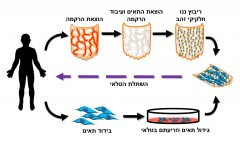Researchers from Tel Aviv University have developed a cardiac patch that combines gold nanoparticles with biological materials from the patient himself, and has the advantage that it will not be rejected by the body

Heart disease is the number 1 cause of death in the Western world, the 'silent killer' responsible for one third of all deaths in the US. As of today, the only solution for serious heart patients is a heart transplant, but as we know, in the current reality it is very difficult to get a heart for transplant. As a result, about half of patients who survive a severe heart attack die within five years.
In a study conducted by Dr. Tal Dvir and student Michal Shabach from the Department of Biotechnology, the Department of Materials Science and Engineering and the Center for Nanoscience and Nanotechnology at Tel Aviv University, they were able to combine in the laboratory biological materials taken from the patients themselves with gold nanoparticles, and produce 'patches' to repair the damaged heart.
The research was recently published in the prestigious journal Nano Letters.
'fix' the damaged heart
"Heart cells are unable to reproduce, and the heart muscle contains only a few stem cells - therefore, when a heart attack causes significant damage to the heart, the heart tissue cannot heal itself," explains Dr. Dvir, a fellow of the American Heart Association. , who won the Marie Curie Award and the Alon Fellowship for Young Researchers and the Heart Research Award from the Slezak Supercenter. "In my lab we strive to engineer sophisticated 'patches' that will be implanted inside the heart and absorbed by it, as a replacement and repair for the damaged heart tissue."
The first challenge that Dr. Dvir and his colleagues faced was to produce tissue for transplantation, which would not be rejected by the body's immune system. To this end, they relied on a working method that is currently accepted in laboratories around the world: growing cells taken from the patients themselves or from other sources on three-dimensional 'scaffolds'. These scaffolds are a substitute for the extracellular collagen network, which supports the heart cells in their natural environment, inside the body. The innovation of the researchers at Tel Aviv University was in the material from which those scaffolds are made.
"Scientists around the world are currently trying to use extracellular networks made from pig heart tissue," says Dr. Dvir. "The problem is that a deposit of antigens remains on these networks (among other things residues of sugars), and the fear is that the patient's immune system will attack biological substances taken from the animal. That's why we proposed a new approach: to harvest adipose tissue directly from the patient's own stomach, in a relatively easy and simple procedure, and then remove the cells from it, leaving only the extracellular network. Such a scaffold, made from the patient's own body tissues, will not stimulate his immune system, nor will it be rejected by it."
Gold in the heart
The next task was to make sure that the engineered tissues produce and transmit the same vital electrical signals that cause the heart muscle to expand and contract. "The biological materials that we harvested from the patient to build the scaffolds are usually insulating materials, so they interfere with the transmission of electrical signals in the cardiac network," explains Dr. Dvir. "To solve the problem, we chose to use gold, a material that conducts electricity on the one hand, and on the other hand does not create a harmful interaction with the tissues of the body."
To achieve the desired effect, the researchers 'decorated' the biological scaffolds with a deposit of gold nanoparticles, and reached a promising result: hybrid patches that contract and expand, and transmit electrical signals efficiently and quickly. First experiments in laboratory animals yielded encouraging findings.
"Now we have to prove that the cardiac patches we developed improve the function of the heart after a heart attack, and are not rejected by the immune system," concludes Dr. Dvir. "Then we will move on to trials on large animals, and later we hope to reach the stage of clinical trials on humans. This is a solution for heart patients, which may in the future save the lives of millions all over the world."

2 תגובות
The revolution will come when they grow a whole new heart with the help of stem cells.
Well done!! Keep it up you are saving lives with every progress.